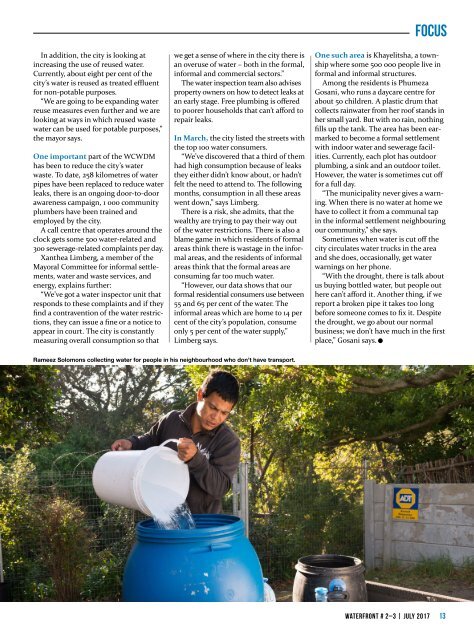Stockholm Water Front no 2-3 2017
You also want an ePaper? Increase the reach of your titles
YUMPU automatically turns print PDFs into web optimized ePapers that Google loves.
In addition, the city is looking at<br />
increasing the use of reused water.<br />
Currently, about eight per cent of the<br />
city’s water is reused as treated effluent<br />
for <strong>no</strong>n-potable purposes.<br />
“We are going to be expanding water<br />
reuse measures even further and we are<br />
looking at ways in which reused waste<br />
water can be used for potable purposes,”<br />
the mayor says.<br />
One important part of the WCWDM<br />
has been to reduce the city’s water<br />
waste. To date, 258 kilometres of water<br />
pipes have been replaced to reduce water<br />
leaks, there is an ongoing door-to-door<br />
awareness campaign, 1 000 community<br />
plumbers have been trained and<br />
employed by the city.<br />
A call centre that operates around the<br />
clock gets some 500 water-related and<br />
300 sewerage-related complaints per day.<br />
Xanthea Limberg, a member of the<br />
Mayoral Committee for informal settlements,<br />
water and waste services, and<br />
energy, explains further:<br />
“We’ve got a water inspector unit that<br />
responds to these complaints and if they<br />
find a contravention of the water restrictions,<br />
they can issue a fine or a <strong>no</strong>tice to<br />
appear in court. The city is constantly<br />
measuring overall consumption so that<br />
we get a sense of where in the city there is<br />
an overuse of water – both in the formal,<br />
informal and commercial sectors.”<br />
The water inspection team also advises<br />
property owners on how to detect leaks at<br />
an early stage. Free plumbing is offered<br />
to poorer households that can’t afford to<br />
repair leaks.<br />
In March, the city listed the streets with<br />
the top 100 water consumers.<br />
“We’ve discovered that a third of them<br />
had high consumption because of leaks<br />
they either didn’t k<strong>no</strong>w about, or hadn’t<br />
felt the need to attend to. The following<br />
months, consumption in all these areas<br />
went down,” says Limberg.<br />
There is a risk, she admits, that the<br />
wealthy are trying to pay their way out<br />
of the water restrictions. There is also a<br />
blame game in which residents of formal<br />
areas think there is wastage in the informal<br />
areas, and the residents of informal<br />
areas think that the formal areas are<br />
consuming far too much water.<br />
“However, our data shows that our<br />
formal residential consumers use between<br />
55 and 65 per cent of the water. The<br />
informal areas which are home to 14 per<br />
cent of the city’s population, consume<br />
only 5 per cent of the water supply,”<br />
Limberg says.<br />
focus<br />
One such area is Khayelitsha, a township<br />
where some 500 000 people live in<br />
formal and informal structures.<br />
Among the residents is Phumeza<br />
Gosani, who runs a daycare centre for<br />
about 50 children. A plastic drum that<br />
collects rainwater from her roof stands in<br />
her small yard. But with <strong>no</strong> rain, <strong>no</strong>thing<br />
fills up the tank. The area has been earmarked<br />
to become a formal settlement<br />
with indoor water and sewerage facilities.<br />
Currently, each plot has outdoor<br />
plumbing, a sink and an outdoor toilet.<br />
However, the water is sometimes cut off<br />
for a full day.<br />
“The municipality never gives a warning.<br />
When there is <strong>no</strong> water at home we<br />
have to collect it from a communal tap<br />
in the informal settlement neighbouring<br />
our community,” she says.<br />
Sometimes when water is cut off the<br />
city circulates water trucks in the area<br />
and she does, occasionally, get water<br />
warnings on her phone.<br />
“With the drought, there is talk about<br />
us buying bottled water, but people out<br />
here can’t afford it. A<strong>no</strong>ther thing, if we<br />
report a broken pipe it takes too long<br />
before someone comes to fix it. Despite<br />
the drought, we go about our <strong>no</strong>rmal<br />
business; we don’t have much in the first<br />
place,” Gosani says.<br />
Rameez Solomons collecting water for people in his neighbourhood who don’t have transport.<br />
WATERFRONT # 2–3 | JULY <strong>2017</strong><br />
13


















